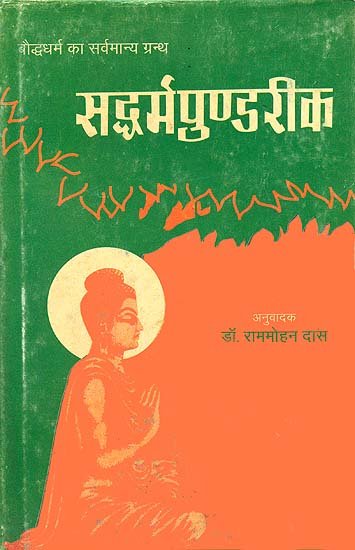Lotus Sutra (Saddharma-Pundarika) [sanskrit]
by H. Kern | 2013 | 16,351 words | ISBN-13: 9788120801226
The Lotus Sutra (Saddharma-pundarika) is an important Mahayana Buddhist scripture classified as one of the nine Dharmas. the Lotus Sutra deals with a wide range of important Buddhist teachings in twenty-seven chapters including the nature of the Buddhas and the inherent potentiality of becoming Buddha within all beings. This editions only contains the Sanskrit metrical text and the corresponding English translation. Alternative titles: Saddharma-puṇḍarīka-sūtra (सद्धर्म-पुण्डरीक-सूत्र).
Verse 13.2
आचारगोचरं रक्षेदसंसृष्टः शुचिर्भवेत् ।
वर्जयेत्संस्तवं नित्यं राजपुत्रेहि राजभिः ॥ २ ॥
ācāragocaraṃ rakṣedasaṃsṛṣṭaḥ śucirbhavet |
varjayetsaṃstavaṃ nityaṃ rājaputrehi rājabhiḥ || 2 ||
Must keep to his course (of duty) and proper sphere; he must be retired and pure, constantly avoid intercourse with kings and princes.
English translation by H. Kern (2013) Buy now!
Glossary of Sanskrit terms
Note: This extracts Sanskrit terms and links to English definitions from the glossary, based on an experimental segmentation of verse (13.2). Some terms could be superfluous while some might not be mentioned. Click on the word to show English definitions.
Acara, Gocara, Asamsrishta, Shuci, Samstava, Nityam, Nitya, Rajaputra, Rajan,
Analysis of Sanskrit grammar
Note: this is an experimental feature and only shows the first possible analysis of the Sanskrit text (Lotus Sutra Verse 13.2). If the system was successful in segmenting the sentence, you will see of which words it is made up of, generally consisting of Nouns, Pronouns, Verbs, Participles and Indeclinables. Click on the link to show all possible derivations of the word.
- Line 1: “ācāragocaraṃ rakṣedasaṃsṛṣṭaḥ śucirbhavet ”
- ācāra -
-
ācāra (noun, masculine)[compound], [vocative single]
- gocaram -
-
gocara (noun, masculine)[adverb], [accusative single]gocara (noun, neuter)[adverb], [nominative single], [accusative single]gocarā (noun, feminine)[adverb]
- rakṣed -
-
√rakṣ (verb class 1)[optative active third single]
- asaṃsṛṣṭaḥ -
-
asaṃsṛṣṭa (noun, masculine)[nominative single]
- śucir -
-
śuci (noun, masculine)[nominative single]śuci (noun, feminine)[nominative single]
- bhavet -
-
√bhū (verb class 1)[optative active third single]
- Line 2: “varjayetsaṃstavaṃ nityaṃ rājaputrehi rājabhiḥ ”
- va -
-
u (noun, masculine)[compound], [adverb], [nominative dual], [vocative dual], [accusative dual]ū (noun, masculine)[compound], [adverb], [vocative single]ū (noun, neuter)[compound], [adverb], [nominative single], [vocative single], [accusative single]ū (noun, feminine)[compound], [adverb], [vocative single]o (noun, masculine)[adverb]au (noun, feminine)[adverb]au (noun, masculine)[adverb]va (noun, masculine)[compound], [vocative single]va (noun, neuter)[compound], [vocative single]
- arjayet -
-
√ṛj (verb class 0)[optative active third single]
- saṃstavam -
-
saṃstava (noun, masculine)[adverb], [accusative single]
- nityam -
-
nityam (indeclinable)[indeclinable]nitya (noun, masculine)[adverb], [accusative single]nitya (noun, neuter)[adverb], [nominative single], [accusative single]nityā (noun, feminine)[adverb]
- rājaputre -
-
rājaputra (noun, masculine)[compound], [vocative single], [locative single]rājaputrā (noun, feminine)[nominative single], [nominative dual], [vocative single], [vocative dual], [accusative dual]
- ihi -
-
√i (verb class 2)[imperative active second single]
- rājabhiḥ -
-
rājan (noun, masculine)[instrumental plural]
Other editions:
Also see the following editions of the Sanskrit text or (alternative) English translations of the Lotus Sutra Verse 13.2
The Lotus Sutra (The Saddharma-Pundarika)
by H. Kern (2013)
The Lotus Sutra (Text with Hindi Translation)
by Ram Mohan Das (2001)
![Lotus Sutra (Saddharma-Pundarika) [sanskrit] - book cover](/uploads/a/Lotus-Sutra.jpg)
